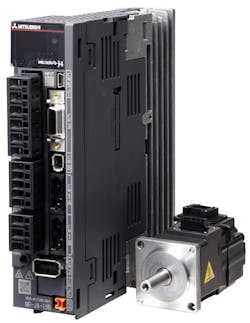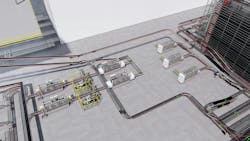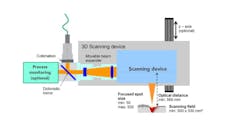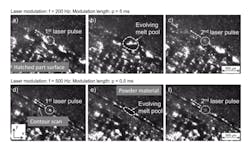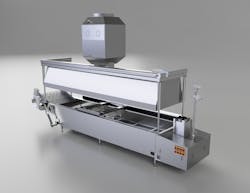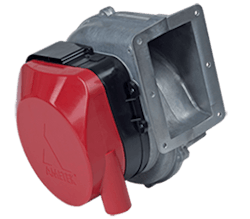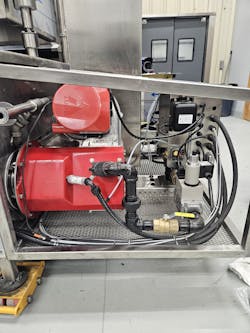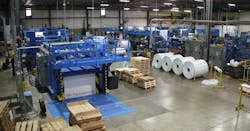What Are They Using? Equipment Choices From Genesis Packaging, AutomationDirect, JD Manufacturing, and More
Have you ever been curious what your main competitor or even just other companies similar to you are using in their facilities? Maybe you saw a machine or piece of equipment and want to know where it was from and if they like it?
In this recurring news round-up, we'll be compiling all the news about who bought what, who delivered what to who, and so on so you can see how other companies are operating and the tools they're using.
OEM Improves Production Output by 300% With Mitsubishi Servo Motors and Amplifiers
Genesis Packaging Technologies moved from a customized to a standardized automation platform, which reduced lead and build times while increasing output by 300%.
Genesis Packaging Technologies, an OEM of vial capping equipment, needed a solution to upgrade its existing line of equipment. Genesis' distributor, Moxley Equipment, recommended Mitsubishi Electric due to its motion control platform.
Genesis' laboratory and high-speed production equipment were upgraded to standardize on off-the-shelf EtherNet/IP MR-J5 Servo Drives and Amplifiers from Mitsubishi Electric. The standardization resulted in half the lead times for their newest machine and production output went from building 5 to 10 machines a year to building 30+ a year. The MR-J4 motion control platform, compatible with third-party devices, allowed Genesis to continue using its existing PLC not manufactured by Mitsubishi Electric.
AutomationDirect Selects TGW Logistics to Improve Georgia DC
AutomationDirect, an automation components and industrial control products supplier, has chosen TGW Logistics to further automate its Cumming, Georgia warehouse.
TGW Logistics will be implementing its FlashPick system for fast and accurate goods-to-person order fulfillment. The system will connect to AutomationDirect's existing mini-load aisles that are used for storage. Comprised of two Stingray shuttle aisles and four ergonomic PickCenter One workstations, the automation will allow AutomationDirect to meet increasing sales demand, handle future SKU growth, and maintain its two-day shipping promise—all within one eight-hour daily shift.
By adding FlashPick and expanding pallet storage, AutomationDirect will be able to easily handle its sales and SKU growth and continue to provide fast two-day shipping for customers.
Together, the two-fold solution optimizes the DC's fulfillment and pallet handling operations and improves the facility's footprint.
An additional component of the solution is the integration of TGW Logistics warehouse software WERX. The software will take over from existing systems, orchestrating both the current automation in the building and the new FlashPick, pallet crane, and conveyor. WERX will manage cycle counts and generate and execute replenishment activities between the inbound mini-loads and order fulfillment shuttles during non-picking hours, preventing potential delays or stoppages and optimizing picking time.
The automation solution will be implemented during ongoing operations and is expected to go live in August 2026.
Aconity3D Enhances Powder Bed Laser Melting Processes With Mikrotron Cameras
Aconity3D GmbH, based in Germany, has made a goal to optimize the stability of metal-based Powder Bed Laser Melting (PBLM) to improve the quality of this technology and promote its use in a wider range of industries.
Used in automotive, medical, and aerospace industries, PBLM is becoming the process for series production due to its flexibility, expanding geometric complexities of manufactured parts, increased choice of materials, and lower costs.
The main challenge of the technique is process stability. The manufactured part can only be checked for defects when it's unpacked from the surrounding powder material at the end of the process, making it impossible to rectify.
To rectify this issue, Aconity3D chose the Mikrotron EoSens 3.0MCX5 3-megapixel industrial camera from SVS-Vistek to implement an optimized imaging system suitable for daily use that records process parameters on parts and enables easier decision-making. The CoaXPress interface delivers a low-latency connection to the host and stable transmission data rates up to 25 Gbit per second.
"With these high-speed cameras, we can, for example, compare contour scans of material layers across the build process and observe the behavior of the melt pool in critical part areas. In this way, we can reliably identify defects such as melt pools breaking off or inhomogeneous surface conditions. The influence of changing laser parameters such as the modulation frequency and modulation length on the size of the melt pool can thus be recognized if all other laser parameters remain constant. The data obtained in this way can be used to expand our knowledge of PBLM processes and isolate the underlying effects," says Lutz Lübbert, Project Manager Machine Development at Aconity3D.
“This high-speed camera uses a sensor where the region of interest (ROI) can be scaled in both the y-direction and the x-direction. The special feature of this sensor is that the frame rate can be increased by reducing the number of pixels in the x-direction. In this way, small ROIs with a high frame rate can be realized, which gives users in every field of application enormous flexibility to adapt the camera precisely to the requirements at hand," explains Karl Laderer, Area Sales Manager DACH, Mikrotron products.
JD Manufacturing Boosts Fryer Output With Bison Blowers
JD Manufacturing, Inc. (JDM), a manufacturer of automatic batch fryers engineered specifically for kettle chip production. The batch frying process imparts kettle chips, whether made from potatoes, sweet potatoes, parsnips, carrots, or beets, with their distinctive premium texture and taste.
JDM's fryers feature a heat exchanger design that enables high production capacity but it also places substantial demands on the blower.
JD Manufacturing required a blower that met several critical constraints:
- Retain the same footprint to fit in the existing enclosure and avoid altering the system size.
- Ensure compatibility with the existing 480V, 3-phase power setup.
- Withstand the harsh conditions of a food production environment, including exposure to moisture, oil-contaminated air, and aerosolized caustic substances.
JDM enhanced its systems with the Nautilair 12.3" High Energy Blower by Bison, for its power density.
According to Joshua Smith, Controls Engineer at JDM, "Our team anticipated that by replacing our three-phase AC motors with brushless DC motors, we could significantly increase power within the same space."
The Nautilair blower, featuring Neodymium magnets, operates more quietly and efficiently. The design of the blower's eight backward-curved fins further boosts performance, reduces noise, and maintains effective cooling.
Smith remarked, "The power density is astounding. We upgraded from a 1 hp AC motor to a 7.5 hp DC motor, all within the same space." He also emphasized that the new blower integrated seamlessly into their existing system, requiring no modifications to the enclosure, power supply, or other components.
An important advantage of the Nautilair blowers is their BLDC controllers that allow for the modulation of blower speed.
Smith highlights that "this innovation significantly enhances our fryers, providing precise control at both low and high flame levels, as well as during pilot conditions. This results in substantial financial benefits for our customers through reduced fuel consumption and increased efficiency, all while minimizing environmental impact.
The switch to the Nautilair blower has increased air pressure, boosting production to 585 lb. of kettle chips per hour—a 17% improvement. Other installations are producing 600 pounds per hour.
"We are planning the integration of Nautilair blowers into our smaller units, aiming to extend these benefits across our entire product line. This strategic move underscores our commitment to delivering high-performance, environmentally conscious solutions that meet the evolving needs of our customers," stated Smith.
Manchester Industries Uses BW Papersystems' Sheeters
Manchester Industries, a Clearwater Paper company that supplies sheeted paperboard, recently enhanced its production in Hagerstown, Indiana, with a 73-inch SheetRunner from BW Papersystems. This sheeting system, designed specifically for high-volume board production, allows Manchester to optimize substrate use, reduce waste, and improve production times.
According to Dave Clark, the production manager at Manchester's facility, the SheetRunner was chosen to increase capacity and improve efficiency, with the automatic slitter providing a huge benefit in minimizing setup times and reducing overtime.
The Hagerstown facility, known for serving commercial printers and folding carton industries, has already seen significant performance gains with the new sheeter. The installation process was seamless, with the machine fully operational within a week.
"We've had the SheetRunner installed and running for a few weeks, and the performance has significantly increased," said Clark. "In one shift, we handled 13 job changes and reached an output of 30 tons, which is impressive for a new sheeter. The machine runs faster with less effort from the operators, allowing them to focus on programming, monitoring, and quality control."
About the Author
Laura Davis
Editor-in-Chief, New Equipment Digest
Laura Davis is the editor in chief of New Equipment Digest (NED), a brand part of the Manufacturing Group at EndeavorB2B. NED covers all products, equipment, solutions, and technology related to the broad scope of manufacturing, from mops and buckets to robots and automation. Laura has been a manufacturing product writer for eight years, knowledgeable about the ins and outs of the industry, along with what readers are looking for when wanting to learn about the latest products on the market.

